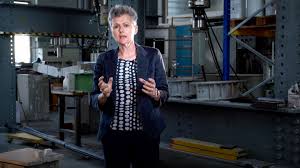(单词翻译:单击)
Concrete is the second most used substance on earth after water, and for this reason, it has a significant environmental impact.
混凝土是地球上仅次于水的第二大最常用物质,因此,它对环境有很大的影响。
If it were a country, it would rank third for emissions after China and USA.
如果混凝土是一个国家,它的排放量将位列世界第三,仅次于中国和美国。
But in fact, concrete is an intrinsically low-impact material
但实际上,混凝土本质上是一种相对环保的材料,
with much lower emissions of CO2 and energy per ton than other materials like iron and steel, even things like bricks.
每吨的二氧化碳和能量的排放量比钢铁,甚至砖等其他材料要低得多。
But because of the enormous volumes we use overall, it contributes to about eight percent of man-made CO2 emissions.
但是由于我们使用的总量巨大,它造成了大约8%的人为二氧化碳排放。
Concrete is an essential material. We need it to house people, to build roads, bridges and dams.
混凝土是一种必不可少的建筑材料。我们需要混凝土来为人们提供住房,修建道路、桥梁和大坝。
So we can't do without it, but we can significantly reduce its carbon footprint.
所以我们不能没有它,但我们可以显著减少它的“碳足迹”。
Concrete is held together by cement. And cement we use today, called Portland cement,
混凝土由水泥粘合在一起。我们今天用的水泥,即波特兰水泥,
is made by heating together a combination of limestone and clay at a temperature of 1,450 degrees Celsius.
是由石灰石和粘土在1450摄氏度的高温下加热制成的。
But in fact, most of the CO2 emissions come not from the heating,
但事实上,大多数的二氧化碳排放并不是来自加热,
but from the breakdown of limestone, which is calcium carbonate, into calcium oxide and carbon dioxide, or CO2.
而是来自石灰石的分解,即从碳酸钙分解成氧化钙和二氧化碳(CO2)。
Now we can't do without this component altogether, because nothing else is so efficient at holding stuff together.
我们非常需要这样的物质,因为没有比它们更有效的粘合剂了。
But we can replace a large proportion of it with other materials with lighter carbon footprints.
但我们可以用碳足迹更小的其他材料替代水泥的大部分成分。
Many colleagues are looking for solutions.
我的很多同事都在寻找相应的解决方案。
And here in Switzerland, we have found that clays produce very reactive materials when they're calcined,
在瑞士,我们发现粘土在煅烧时会产生非常活跃的物质,
that's to say heated to around 800 degrees Celsius, significantly lower than the 1,450 needed to produce cement.
只需要加热到800摄氏度左右,大大低于生产水泥所需的1450摄氏度。
But more importantly, there's no CO2 emissions from the decomposition of limestone.
但更重要的是,石灰石分解并不会产生二氧化碳。

We then take this calcined clay, and we add a bit of limestone -- but this time not heated, so no CO2 emissions
然后我们在煅烧过的粘土中加入一点石灰石--但这次没有加热,所以没有二氧化碳排放,
and some cement, and this combination of limestone, calcined clay and cement, we call LC3.
还有一些水泥,这种由石灰石、煅烧过的粘土和水泥组成的混合物,我们称之为LC3。
Now this LC3 here has the same properties as Portland cement.
LC3与波特兰水泥具有相同的性质。
It can be produced with the same equipment and processes and used in the same way, but has up to 40 percent lower CO2 emissions.
可以用相同的设备和工艺生产,并以相同的方式使用,但却可以降低近40%的二氧化碳排放。
And this was demonstrated in this house we built near Jhansi in India,
关于这一点,我们在印度的贾尼斯附近建造的房子中已经得到了证明,
where we could save more than 15 tons of CO2, which was 30 to 40 percent compared to existing materials.
二氧化碳的排放量减少了15吨,与现有材料相比,相当于降低了30%到40%。
So why isn't everybody already using LC3? Well, cement is a local material.
那么为什么LC3的使用还没有普及呢?事实上,水泥是一种本地的材料。
The reason Portland cement is so pervasive is that it's produced from the most abundant materials on Earth
波特兰水泥如此普及的原因在于,它是由地球上含量最丰富的材料制成的,
and can be produced in India, in the United States, in Ethiopia, almost anywhere.
可以在印度、美国、埃塞俄比亚等几乎任何地方生产。
And we have to work with people locally to find the best combination of materials to make LC3.
我们必须与当地人合作,以找到制作LC3的最佳材料组合。
We have already done full-scale trials in India and Cuba.
我们已经在印度和古巴进行了全规模的试验。
In Colombia, a product based on this technology was commercialized a few months ago,
在哥伦比亚,一种基于这种技术的产品几个月前已经商业化,
and in the Ivory Coast, the full-scale plant is being commissioned to calcine clays.
在科特迪瓦,一家全规模的工厂已受到委托,正在煅烧粘土。
And many of the world's largest cement companies are looking to introduce this in some of their plants soon.
许多世界上最大的水泥公司都希望能够尽快在他们的一些工厂中引入这种技术。
So the possibility to replace Portland cement with a different material
因此,用不同的材料替代波特兰水泥,
but with the same properties, produced in the same processes and used in the same way, but with much lighter carbon footprint
这些材料具有相同的性能,利用相同的工艺生产,以相同的方式使用,但碳足迹要小得多,
is really crucial to confront climate change because it can be done fast and it can be done on a very large scale
这对于应对气候变化至关重要,因为这一过程可以快速、大规模的实现,
with the possibility to eliminate more than 400 million tons of CO2 every year.
每年有可能消除4亿吨以上的二氧化碳排放。
So we can't do without concrete, but we can do without a significant amount of the emissions it produces. Thank you.
所以,虽然我们不能没有混凝土,但我们可以大大减少它的碳排放。谢谢大家。


